Harnessing the power of the Sun: fusion reactors Understand article
Renewable, clean, unlimited energy – how can it be achieved? Christine Rüth from EFDA introduces the tokamak, the most advanced fusion device.
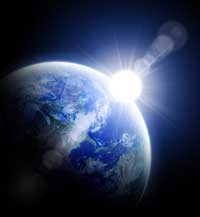
/ Pixelio
The Sun produces vast amounts of energy by fusing light atomic nuclei into heavier particles. If scientists could make this process work sustainably on Earth, we would have a nearly inexhaustible and climate-friendly energy source. A 1 gigawatt fusion power plant would consume only 250 kilograms of fuel per year and produce electricity without emitting carbon dioxide. A coal-powered plant with the same capacity burns 2.7 megatonnes of coal each year.
And unlike fission, fusion is not a chain reaction, which makes it inherently and reassuringly safe: to halt the reaction, it is necessary only to stop the supply of fuel. Furthermore, although some components of a fusion reactor will become radioactive during operation, this radioactivity is short-lived: the materials can be safely disposed of after about 100 years, as opposed to the many thousands of years required for a fission reactor (for more details, see Warrick, 2006).

plant will fuse tritium (two
neutrons, blue, one proton,
red) and deuterium (one
neutron, one proton) nuclei,
generating a helium-4
nucleus and a highly
energetic neutron
Image courtesy of EFDA-JET
Scientists at Europe’s largest fusion experiment, the Joint European Torus (JET) in Culham, UK, have been making significant progress towards fusion energy for more than 30 years. Nonetheless, the JET experiment still requires more power than it generates – which is not good for a power plant. The next step will be the international experiment ITER, due to be switched on in 2019. ITER is expected to be the first to produce a net power surplus – 500 megawatts from a 50 megawatts input (see Warrick, 2006). This would prove that fusion power plants are viable.
So how does fusion work?
To achieve fusion on Earth, scientists picked the most efficient reaction that takes place in the Sun – the fusion of two isotopes of hydrogen: deuterium and tritium. This reaction yields a helium-4 nucleus and a neutron, which carries 80% of the fusion energy (Figure 1). These fast neutrons are captured in the steel wall of the fusion reactor, which transfers the heat to cooling fluids within the wall, which in turn drive a turbine to produce electricity.
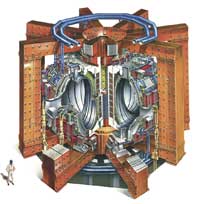
of the tokamak JET showing
the steel vessel surrounded
by eight large copper coils,
which produce the magnetic
fields. Note the person on
the left to give an
indication of size
Image courtesy of EFDA
The fusion device
Currently, the most advanced type of fusion device is the tokamak. At the heart of a tokamak is the reactor, a ring-shaped steel vessel with numerous openings for heating, measurement and other systems, and an inner wall lined with removable heat-resistant tiles (Figure 2). To start the fusion process, the vessel is subjected to high vacuum – at JET, this value is around 0.00000001 millibar – and a few grams of deuterium and tritium gas are injected. The gas is heated to above 10 000 °C, at which point the electrons escape from their nuclei. This ionised gas is called plasma, or the fourth state of matter; it is the basis for producing fusion power.
Conditions for fusion
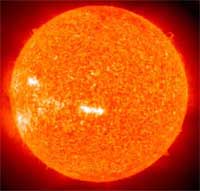
Extreme Ultraviolet Imaging
Telescope aboard the Solar
and Heliospheric Observatory
(SOHO), stationed 1.5 million
kilometres from Earth
Image courtesy of ESA, NASA,
SOHO / EIT team
Getting nuclei to fuse is no easy feat: they are positively charged and repel each other, so they must collide at extremely high speeds to fusew1. Because particle speed corresponds to temperature, the plasma has to be millions of degrees Celsius before the fusion process will start. Although the plasma loses heat at its edges, it can keep itself hot by absorbing energy carried by the helium nuclei produced in the reaction, and this self-sustained fusion process can continue as long as new fuel is injected. However, the challenge is to reach that state and ignite the plasma. To ignite, the plasma must be hot enough, dense enough (to ensure a sufficient fusion reaction rate) and keep its energy for long enough – this last condition is called the confinement time.
The product of the three parameters – temperature, density and confinement time – is the triple product,a central parameter in fusion science. Typically, for the fusion reaction to start, the plasma has to be 100-200 million °C, with a density of about 1020 particles per cubic metre, (approximately 1 mg/m3, one millionth of the density of air) and this state must be confined for around 3-6 secondsw2. Such a high temperature sounds challenging, but heating is not the problem (see below). Instead, it is the confinement time that is hard to achieve – maintaining that temperature (and density) – because the plasma rapidly loses energy as well as particles (which also carry energy).
How does a tokamak work?
1) Keeping the plasma together: magnetic fields
To maintain the high temperature and protect the reactor walls (which would otherwise erode quickly), the plasma needs to be kept away from the reactor walls. To do this, fusion scientists exploit the Lorentz force experienced by a moving charged particle when a magnetic field is applied. This force is perpendicular to both the particle’s direction of travel and the magnetic field, and therefore causes the particle to rotate around the magnetic field line. As a result, the particle spirals around the field line – with electrons and nuclei moving in opposite directions (Figure 3).

F = qE + qv × B
The first term (qE) is contributed by the electric field. The second term (qv x B) is the magnetic force and has a direction perpendicular to both the velocity v and the magnetic field B. The magnetic force is proportional to q and to the magnitude of v × B. In terms of the angle ϕ between v and B, the magnitude of the force equals qvB sin ϕ.
(Source: Encyclopædia Britannica Online (magnetic force: moving charges). Accessed 23 January 2012. www.britannica.com/EBchecked/media/1319/
Magnetic-force-on-moving-charges)
A: Moving charged particles in a magnetic field are subject to the Lorentz force and spiral around the field lines. Positively and negatively charged particles spiral in opposite directions.
B: The particles’ movement without a magnetic field
Images courtesy of EFDA
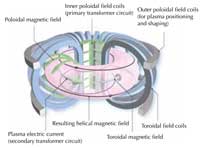
coils, together with a plasma
current, create the helical
magnetic field that confines
the plasma. The inner
poloidal field coils in the
central solenoid induce the
plasma current.
Click on image to enlarge
Image courtesy of EFDA
The most advanced magnetic confinement design is the tokamak, a ring-shaped vacuum chamber surrounded by coils. An electric current flowing through one set of coils (the toroidal field coils, Figure 4) generates a ring-shaped magnetic field. The strength of this toroidal (doughnut-shaped) field is not uniform across the ring, because the coils are closer together on the inside of the torus (doughnut). Therefore the particles experience a stronger Lorentz force on the inner side of the field line around which they are rotating. As a result, they gradually drift away from their field line towards the plasma edge.
To reduce this effect, a second magnetic field, the poloidal field, is generated. The resulting helical magnetic field winds in spirals around the plasma and confines it very effectively. The easiest way to generate a poloidal field is with a plasma current.
That in turn is generated when the plasma particles travel along the ring around the toroidal field lines – electrons and ions moving in opposite directions. Like a wire, this current creates a ring-shaped magnetic field around itself. It is induced by a transformer in which the plasma itself acts as a secondary coil around a large primary coil (the inner poloidal field coils). Because the plasma tends to drift vertically, an additional magnetic field created by the outer poloidal field coils is used to control its position and shape.
2) Heating
To heat the plasma to 100-200 million °C, fusion scientists use three complementary systems (Figure 5).
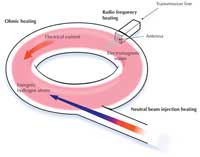
of 100-200 million °C, three
complementary heating
systems are used: ohmic
heating, neutral beam
injection and radio
frequency heating.
Click on image to enlarge
Image courtesy of EFDA
- The plasma current produces heat (ohmic heating) itself – just as a wire warms up when an electric current flows through it.
- Beams of high-energy particles, usually hydrogen atoms, are injected into the plasma, where they transfer their energy to the plasma particles via collisions (think of a fast billiard ball hitting a slower ball, which then speeds up). The particle beam is generated by accelerating ions with high voltage. Because charged particles cannot penetrate the magnetic field around the plasma, they are turned into neutral atoms before injection.
In practice, this is no easy task. To give the particles the necessary velocity, a particle accelerator relies on the attractive force that a high voltage exerts on a charged particle (or ion). However, only uncharged (neutral) particles can penetrate the magnetic field around the plasma, so the (uncharged) hydrogen atoms must first be stripped of their electrons, accelerated and then neutralised again before injectionw3.
- Antennae in the vessel wall are used to propagate electromagnetic waves of certain frequencies into the plasma. These cause the spiralling plasma particles to resonate and absorb the wave energy.
Why is fusion power taking so long?
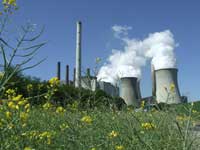
powered by fusion?
Image courtesy of Khánh
Hmoong; image source: Flickr
In the 1970s, scientists believed that once they could heat the plasma sufficiently and create large enough magnetic fields, they would have reached the goal of fusion energy. But the plasma has turned out to be highly unstable and loses much more energy than they expected. Since then, scientists have been investigating the physics behind these phenomena and developing methods to control these instabilities. If, as expected, ITER finally generates a net surplus of fusion power, these issues can be considered to be solved and the first fusion power plant could be in operation by 2050.
Fusion energy
The fusion of one tritium (T) and one deuterium (D) nucleus releases 17.6 MeV of energy, 80% of which – 14.1 MeV – is carried by the neutron and can be used to produce electricity. Fusing 1 kg D with 1.5 kg T (the mass of T is 1.5 times that of D) yields 14.1/(2*1.67262*10-27) = 4.2*1027 MeV, taking into account that one D nucleus comprises one proton and one neutron, each weighing 1.67262·10-27 kg.
One kilogram of D contains 3·1026 nuclei (one D nucleus comprises one neutron and one proton, each weighing 1.6·10-27 kg). Fusing 1 kg of D (with 1.5 kg of T, as the mass of T is 1.5 times that of D) therefore results in 3·1026 fusion reactions and yields 14.1 x 3·1026 = 4.2 x 1027 MeV of energy.
A fusion power plant with an efficiency of 40% could generate 70 GWh of electricity (with 1 eV = 1.6*10-19 J or Ws) from 1 kg D, enough to supply 20 average households in an industrial country.
Deuterium can be extracted from seawater, which contains 35 grams per cubic metre. Tritium is not found in large quantities in nature but can be obtained from the light metal lithium, with the aid of some of the neutrons produced in the fusion reaction:
6Li + n => 4He + 3H + energy
or in a similar reaction with 7Li. Most of Earth’s minerals contain lithium, 2.3 kg of which yields 1 kg tritium. A fusion power plant producing 1 GW electricity (a capacity similar to those of nuclear fission plants) will use 150 kg T and 100 kg D per year.
More about EFDA-JET
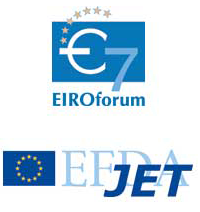
As a joint venture, JET is collectively used by more than 40 European fusion laboratories. The European Fusion Development Agreement (EFDA) provides the platform to exploit JET with more than 350 scientists and engineers from all over Europe currently contributing to the JET programme.
EFDA-JET is a member of EIROforumw4, the publisher of Science in School.
Acknowledgement
Thanks are due to Örs Benedekfi, former head of EFDA public information, for his contribution to this article.
References
- Warrick C (2006) Fusion – ace in the energy pack? Science in School 1: 52-55.
Web References
- w1 – At the 2007 Science on Stage international teaching festival, Zoltán Köllö won a prize for his simple demonstration of nuclear fusion and the Coulomb barrier using a couple of drops of water and the base of a drinks can. To learn how to do it, see: www.esa.int/SPECIALS/Science_on_Stage/SEMRE58OY2F_0.html
- To find out more about Science on Stage, the network of European science teachers, see: www.scienceonstage.eu
- w2 – To learn more about fusion, fusion reactors and EFDA-JET, see: www.efda.org
- In particular, for the full story of JET, its design and results, see: http://tinyurl.com/scienceofjet
- To watch a video of a plasma pulse in JET, see the multimedia section of the EFDA website (www.efda.org/multimedia; ‘Video Gallery’ then ‘JET Experiment’) or use the direct link http://tinyurl.com/plasmapulse
- w3 – For more details of how the high-energy particle beams are produced, see the EFDA website (www.efda.org) or use the direct link: http://tinyurl.com/neutralbeam
- w4 – To find out more about EIROforum, see: www.eiroforum.org
Resources
- To learn more about fusion in the Sun, see:
- Westra MT (2006) Fusion in the Universe: the power of the Sun. Science in School 3: 60-62.
- For a comprehensive overview of fusion research in Europe, including background information on plasma physics and reactor types, as well as wonderful animations and videos, see: www.efda.org
- To find out how scientists accidentally created plasma in their microwave, and how they used it for their research, see:
- Stanley H (2009) Plasma balls: creating the 4th state of matter with microwaves. Science in School 12: 24-29.
Institutions
Review
This article describes the research into producing electrical energy by the fusion of light atomic nuclei – just as the Sun does. It offers physics or science teachers a detailed overview of how fusion works, and what the challenges are to producing energy in a fusion power plant.
The issues of climate change and the greenhouse effect mean that many countries have to solve the problem of how to produce renewable energy in a sustainable way. This article therefore could be useful not only for physics lessons, but also for biology, geography and language lessons.
The article would stimulate discussion around a broad range of questions, including:
- How does fusion work?
- Why, even after 30 years of research, are we not yet producing energy from fusion power plants? What are the challenges?
- What could be the advantages of using fusion reactors?
- Is the production of energy by fusion sustainable?
Gerd Vogt, Higher Secondary School for Environment and Economics, Yspertal, Austria





